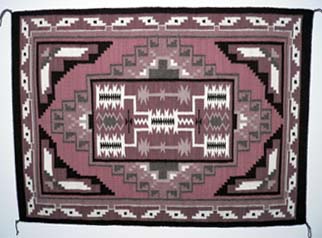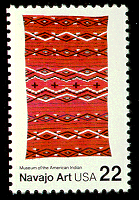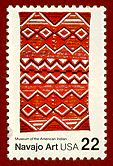|
Burnt Water Navajo rug from the collection of Judy
Breneman

"The Navajos say that if you are a fine weaver, you have been blessed
with this talent by the Holy People, and they are responsible for the art. You
must acknowledge them, and you must live right on this earth."
from
"Woven by the Grandmothers", p29
Traditional Navajo weaving was steeped in religion. Children were taught about
how Spider Woman and Spider Man constructed the first loom. The colors in a
Navajo rug all have meaning and the very act of weaving a well balanced design
is a part of the Navajo way of living in balance with natural order.
Traditional weaving also involved the knowledge of weaving songs and prayers
associated with weaving. Although some of this traditional aspect has been lost
Navajo weaving continues to be some of the finest on earth.
WEAVING PREPARATION AND TECHNIQUES
Traditionally the Navajo loom was set up between two young trees or sturdy
posts were secured in holes. A lower and upper beam was attached to these side
supports. A smooth straight stick or dowel was suspended from the upper beam
while another was lashed to the lower beam. Since the upper bar is adjustable
it can be use to adjust the tension. The warp thread was strung back and forth
in a figure 8 between these two inner sticks or beams. Modern day Navajo looms
are made from frames rather than logs and saplings so many are portable. Others
are attached to doorframes or to the ceiling and floor.
Although some Navajo men
weave, traditionally it has been the Navajo women who
have been responsible for weaving from caring for the sheep to the final
weaving of the wool yarns. Today many weavers buy their yarn for weaving though
there is a trend to going back to the old ways. Some are raising improved
breeds of sheep then sending the wool to be commercially produced into yarn.
The dying may or may not be done commercially.
There were only a few dyes used in the early Navajo blankets. Indigo dye was
used some but was expensive and hard to make into a usable form. Natural yellow
dyes were produced from the flowers of rabbit brush. Occasionally indigo and
yellow dye was combined to make green dye.
US
Postage Stamp issued 9/4/86
Courtesy of
Designsetc.com
website
 Although the cochineal beetle was
used to make red dye in the southwest for unknown reasons this capability was
not known to the Navajo. Because red dye wasn't available to the them until the
late 1800s weavers unraveled red yarns from pre-dyed trade cloth to use in
their weaving. Although the cochineal beetle was
used to make red dye in the southwest for unknown reasons this capability was
not known to the Navajo. Because red dye wasn't available to the them until the
late 1800s weavers unraveled red yarns from pre-dyed trade cloth to use in
their weaving.
In the late 19th century, synthetic dyes became available at the trading posts.
Initially they tended to fade but later better quality dyes became available.
The availability of these dyes encourages the Navajo to experiment with more
varying colors. Synthetic dyes continue to be used in some Navajo weaving.
In the first half of the 1900s traders began to encourage weavers to use plant
based dyes again. The theory behind this was that Anglo-Americans would be more
interested in rugs made with natural dyes. They also resulted in a softer look
than is seen with the harsher synthetic dyes. This revival of use of vegetable
dye was far different from early yarn dying. An effort was made to find a
multiple plant sources resulting in a wide variety colors that are now used in
Navajo rugs. Over 200 vegetal dyes are used today from a great variety of
native plant sources including walnut hulls, rose hips, alder bark, onion skin,
and many more. Leaves, stems, flowers, berries, roots and nuts were all
considered possibilities for dye.
We cannot be certain when the first Pueblo weaver taught a Navajo to weave. We
know some Pueblo people fled to hide with the Navajo when the Spanish were
attacking the Pueblo villages during the 16th and 17th centuries. The mixing of
the two cultures included sharing of weaving techniques. Pueblo people used a
plain basket type weave, one over and one under with equal both warp and weft
threads showing on each side. They continue to use it this plain weave today in
making their ceremonial garments.
Over the years the Navajo developed a tapestry weave which has been their
dominant weaving technique for over 200 years. In this form of weaving the weft
is loosely placed then packed down tightly with the fork resulting in a textile
in which the warp is not visible. The fork functions like a weaving comb but
has a long handle. The fineness of the weave can vary dramatically from course
to extremely fine. The weaving is done in sections measured by the weavers
reach. This means the color of the yarn used must be changed frequently. On a
large rug you might be able to discern where the weaver ended each section.
NAVAJO REGIONAL WEAVING STYLES
US Postage Stamp issued 9/4/86
Courtesy of Designsetc.com
website
 The Navajo reservation covers over 26,000 square miles including a huge chunk
of northeastern Arizona and parts of Utah and New Mexico. Until motorized
transportation was common each scattered community was fairly isolated. Over
time, weaving designs evolved into several distinctive regional styles. Often
the Navajo weavers in an area were influenced by the owner of the local trading
post. Each trader's goal was to get the best price possible for the Navajo's
rugs. Because of this Anglo-Americans taste has become a part of Navajo rug
design. Following are descriptions of the major styles. Each was named after
the area where that style of rug originated The Navajo reservation covers over 26,000 square miles including a huge chunk
of northeastern Arizona and parts of Utah and New Mexico. Until motorized
transportation was common each scattered community was fairly isolated. Over
time, weaving designs evolved into several distinctive regional styles. Often
the Navajo weavers in an area were influenced by the owner of the local trading
post. Each trader's goal was to get the best price possible for the Navajo's
rugs. Because of this Anglo-Americans taste has become a part of Navajo rug
design. Following are descriptions of the major styles. Each was named after
the area where that style of rug originated
-
Wide Ruins style rugs have horizontal bands with stepped diamonds
and no border. Colors are from natural and vegetal dyes.
-
Ganado style rugs usually have a black outside border with strong
geometric patterns. This is the style greatly influenced by Juan Lorenzo
Hubbell. commercially dyed reds often dominate these quilts.
-
Two Gray Hills style rugs often have a black or dark border as
well. Natural wool colors of gray, brown and cream are used with. Some of
the blacks are dyed. Geometric patterns radiating out from the center are
common. The resulting rugs are of wonderful soft earth tones.
For pictures: Two
Grey Hills Trading Post of authentic Navajo rugs, est. 1897
-
Crystal style rugs are done in both bordered designs with centrally
radiating geometrics and horizontal bands with geometric patterns in some of
the bands.
-
Teec Nos Pos style rugs excel in intricate geometrics. There is a
strong Persian rug influence in the designs of these rugs. Wide porters have
additional geometric designs. Bright commercially dye wool increased
contrast in these rugs.
-
Chinle style rugs display horizontal band with stepped diamond
patterns within some of the bands. Both commercial and vegetal dyes are
used.
-
Shiprock pictorial style rugs are unique among Navajo rugs. They
display pastoral scenes, tree of life motifs and designs based on Sand
Paintings.
-
Western Reservation style rugs include the traditional 'storm
pattern' with a central rectangle with four line extending from the corners
to four smaller rectangles in the corners of the rug. In addition this
region has developed a technique in which raised outlines are woven into
geometric patterns. This is done by using a contrasting weft thread over two
warp threads instead of one.
-
Burntwater style rugs are more recent and are
influenced by other
older styles. Typically they are geometrics radiating out from the center or
two spaced apart centers. Most have patterned borders. The use of vegetable
dyed commercial yarns of soft colors is common. Some radiate in soft pastel
shades.

This Burntwater rug (same rug at top of article) has a rug in a rug with the
inner rug showing a storm pattern showing a Western Reservation influence.
Shown with permission from Judy Breneman.
MODERN DAY TRENDS
In modern time there has been much more communication between different areas
of the Navajo reservation. Regional styles are no longer made in a single
region. Instead many weavers weave in more than one style. There has been a
trend of Navajo wool being sent to a commercial plant to be processed into wool
then returned to the weavers. There has been a return back to using natural
plant dyes but in far more varied colors. In come cases these vegetal-dyes are
applied by the weaver but more often the yarns are dyed commercially but with
vegetal-dyes. The result is wonderful new earth tones and pastels being used in
rugs. Most of the newer Navajo rugs can be seen more as tapestries to hang on a
wall. They are lighter weight and of a fine weave.
Judy Breneman 2005
Judy writes two quilt history Web sites: History
of Quilts, and Womenfolk.
Navajo Weaving From Spider Women to Chief's Blankets by Judy.
See also:
Navajo Weaving From 1862 to the Present
For article on the Navajo
Rug Postage stamps released in 2004
|